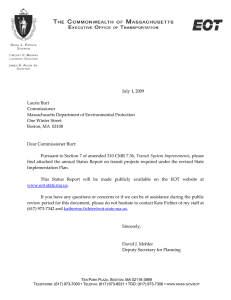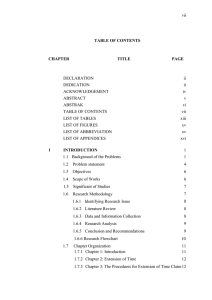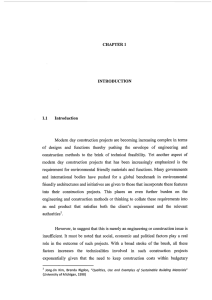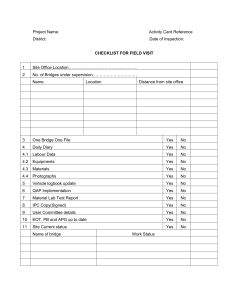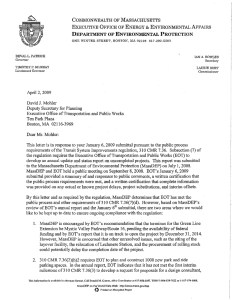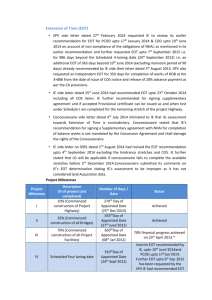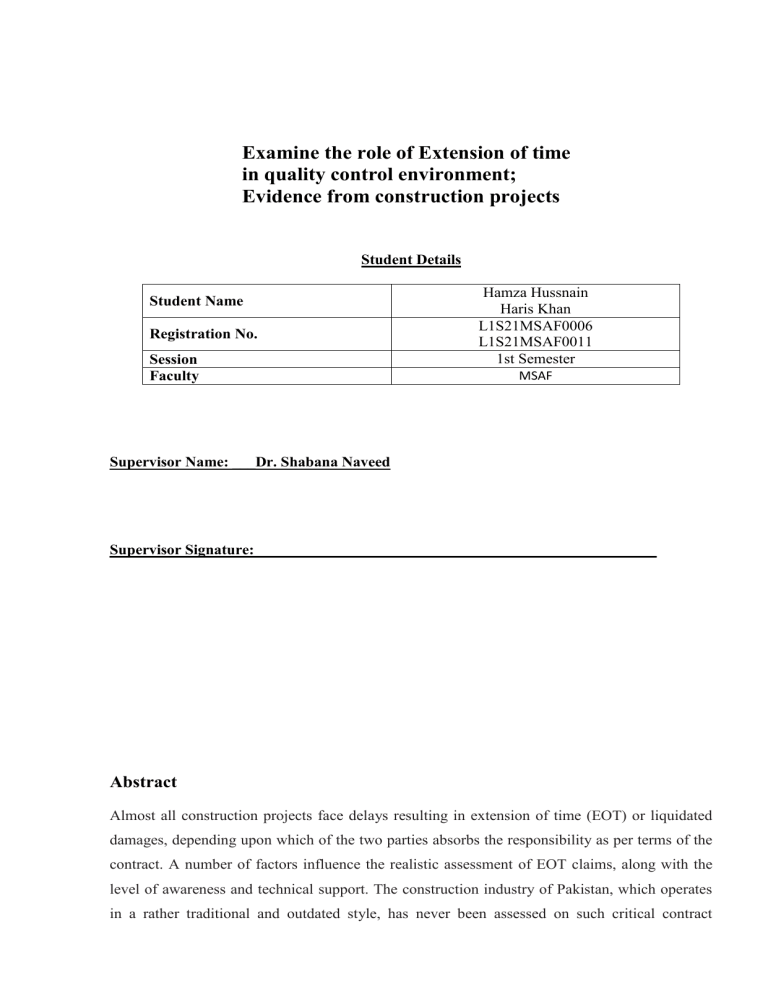
Examine the role of Extension of time in quality control environment; Evidence from construction projects Student Details Student Name Registration No. Session Faculty Hamza Hussnain Haris Khan L1S21MSAF0006 L1S21MSAF0011 1st Semester MSAF Supervisor Name: ___Dr. Shabana Naveed Supervisor Signature: ____________________________________________________ Abstract Almost all construction projects face delays resulting in extension of time (EOT) or liquidated damages, depending upon which of the two parties absorbs the responsibility as per terms of the contract. A number of factors influence the realistic assessment of EOT claims, along with the level of awareness and technical support. The construction industry of Pakistan, which operates in a rather traditional and outdated style, has never been assessed on such critical contract management aspects. It has resulted into various disputes, court cases, and bad blood between stakeholders. To help facilitate the local practitioners, this study analyzed 29 EOT-influencing factors. Prevalent practices in the construction industry also were investigated. On the basis of an extensive survey, it was found that delayed payment to the contractor was the primary cause of EOT claims. Conclusions were drawn and reommendations are proposed to resolve EOT issues, float ownership, and prolongation cost. Almost all construction projects face delays resulting in extension of time (EOT) or liquidated damages, depending upon which of the two parties absorbs the responsibility as per terms of the contract. A number of factors influence the realistic assessment of EOT claims, along with the level of awareness and technical support. The construction industry of Pakistan, which operates in a rather traditional and outdated style, has never been assessed on such critical contract management aspects. It has resulted into various disputes, court cases, and bad blood between stakeholders. To help facilitate the local practitioners, this study analyzed 29 EOT-influencing factors. Prevalent practices in the construction industry also were investigated. On the basis of an extensive survey, it was found that delayed payment to the contractor was the primary cause of EOT claims. Conclusions were drawn and recommendations are proposed to resolve EOT issues, float ownership, and prolongation cost. Almost all construction projects face delays resulting in extension of time (EOT), depending upon which of the two parties absorbs the responsibility as per terms of the contract. A number of factors influence the realistic assessment of EOT claims, along with the level of awareness and technical support. The construction industry, which operates in a rather traditional and out dated style, has never been assessed on such critical contract management aspects. It has resulted into various disputes, court cases, and bad blood between stakeholders. To help facilitate the local practitioners, this study analyzed 29 EOT-influencing factors. Prevalent practices in the construction industry also was investigated. On the basis of an extensive survey, it was found that delayed payment to the contractor was the primary cause of EOT claims. Conclusions were drawn and recommendations are proposed to resolve EOT issues, float ownership, and prolongation cost. Key words: Extension of time, Quality control environment, Construction projects. • Introduction 1.1 Background of Research Project success has many dimensions, one of which is timely completion (Fawzy and EL-adaway 2013). It has been argued that it is the most important matric to measure project success (Ullah et al. 2016). It is reported that 70% of projects, on average, face delays that extend their duration by 10–30% (Assaf and Al-Hejji 2006). Similarly, Aibinu and Jagboro (2002) reported that construction delays are responsible for 36–64% of cost overruns. Some delay causes can be attributed to the contract, whereas some are beyond the control of stakeholders, such as force majeure. In this regard, Aibinu (2009) suggested the use of precontract negotiation to avoid and mitigate delay claims. However, concerted efforts are exercised to avoid it; once occurred, the delay may result in either liquidated damages to the contractor, an extension to stipulated time of completion, or monetary compensation to the contractor (Hanna et al. 2016). The decision for one of these measures depends on the responsibility of delay, established with the help of proper investigation and analysis (Muhamad et al. 2016). Construction delays are caused by several factors, including internal and external process time, errors in documentation, unrealistic contract period, improper resource, and risk allocation (Hanna et al. 2016; Larsen et al. 2015). As a result of delays caused by the client, an extension of time (EOT) is granted to the contractor. However, EOT claims are not always resolved so amicably owing to confrontational approaches adopted by various parties. Literature suggests that, globally, EOT claims are on rise. According to Odeh and Battaineh (2002), the average ratio of actual completion time to the planned contract duration is 160.5% for road projects and 120.3% for building projects because of the delays and EOT claims.. To avoid any conflicts and reach a mutually beneficial solution, a number of analytical methods are available, such as window analysis and time impact analysis. (Muhamad et al. 2016). These methods take into consideration various factors identified through literature review and interviews that directly or indirectly affect the realistic determination of EOT (Muhamad et al. 2016; Birgonul et al. 2014). 1.2 Research Gap Extension of time is the compensation granted to the contractor in the case of delays for which he is not responsible to prevent incurrence of undue liquidated damages (Eladaway et al. 2016). According to Anuar Othman et al. (2006), EOT is a result of an excusable delay that occurs when a contractor is behind schedule because of events beyond his control. The Society of Construction Law’s (SCL) (2002) Delay and Disruption Protocol states that a major benefit of EOT to the contractor is the relief from the liability of liquidated damages, whereas the client may benefit from avoiding the situation of time-at-large. Construction delays may be categorized into four groups: critical versus noncritical delays, excusable versus no excusable delays, compensable versus no compensable delays, and concurrent delays. According to Mubarak (2015), resolving delay claims is one of the core objectives of scheduling a project. Construction schedules have been used widely for resolving delay claims (Babar et al. 2016;Perera et al. 2016). According to Nguyen and Ibbs (2008), the five most commonly used methodologies for delay analysis are: (1) as-planned versus as-built (total time) method, (2) impacted as-planned (what-if) method, (3) collapsed as-built (but-for) method, (4) windows analysis method, and (5) time impact analysis (modified as-built) method. Compensation for prolongation cost is also an important issue when dealing with delay claims. Standard contract forms, especially that of the International Federation of Consulting Engineers (FIDIC), entitle the contractor to recover prolongation compensation for time-related resources and site overheads. As per the core principle proposed by the protocol, the objective is to put the contractor in the same financial position he would have been in if the employer risk event had not occurred. • Significance of Research In recent decades, projects have tended to become more time-constrained and ability to deliver a project on-time has becoming an increasingly important element in winning a bid. There is an increasing emphasis on tight contracts by using prime contractor ship to pass time-risk onto the contractor, frequently with heavy liquidated damages (LADs) for lateness. Delays are a major source of claims and disputes in construction projects and have even been cited as the most common and costly causes of problems. Furthermore, local practice is doubtful in the process of claiming and assessing the extension of time. There is no standardized procedure or protocol for both contractors and clients. Therefore, it is essential to reveal the local practice on EOT before any recommendation of methods to reduce EOT claim. 1.4 Research Questions This study has following research questions: • How the organizations will apply for extension of time in quality control environments? • How do project team members evaluate the techniques for EOT? • How the project team members can be avoided from the liquidated damages in regards to EOT. • Definition of key constructsws This writer has seen quite a number of in-house drafted contracts which do not provide for an extension of time (hereinafter referred to as “EoT”) clause for the declared reason that, in the absence of such a provision, the Contractor would not be able to claim for extension of time and hence, on that pretext, no claim for “loss and expense” can be entertained. Almost always, those contracts also contain a provision for the imposition of liquidated damages (hereinafter referred to as “LD”) for delay to completion. Further, there are also a considerable contract which this writer has seen which attempt to limit as much as possible the grounds on which the Engineer/Architect/S.O. can grant EoT. With respect, such over-zealousness in protecting one party may be counter-productive and glaringly displays an ignorance of the purpose, and legal implications, of EoT clause in construction contracts. To properly understand this, an understanding of the concept of what is called the “prevention principle” is necessary. • Theoretical Framework • Base theories Time of the Essence The possible legal consequences that can flow from the Contractor’s failure to complete the Works within the contractual time can be inferred from the provisions of section 56 Contracts Act 1950. In Tan Ah Kian v. Haji Hasnan,8 Gill CJ identifies the following three situations when time would be of the essence: (a) the parties expressly state in the contract that it shall be so; (b) where it was not originally stated to be of the essence but it was subsequently made so by one party giving reasonable notice to the other who has failed to perform the contract with sufficient promptitude; or (c) where from the nature of the contract or of its subject matter time must be taken to be of the essence. Time at Large Time for completion of the Works is said to be “at large” when the Contractor’s obligation to complete the Works within the specified time or certified extended time is lost. That is to say, the Contractor is no longer bound by the contract provision that he has to complete the Works by a certain date or extended date. The obligation of the Contractor is then to complete the Works within what is called “reasonable time”. Reasonable Time The question of what duration of time is reasonable is one of fact, not law. It is a question of fact taking into consideration all relevant factors and circumstances, objectively assessed. Regrettably as it is, this is one of the elastic concepts for which there will be no fixed answer. The Meaning of Completion There have been many shades of opinion as to what constitute “completion” and the use of some phrases in certain standard forms of building and construction contracts such as “practical completion”, “substantial completion” and others certain do not help. Further, the standard forms of building and construction contracts also do not define the meanings of such phrases. In most standard contract forms, “completion” also marks the commencement of defects liability period and also the release of half of the retention monies. There have been a number of judicial decisions attempting a legal definition of the terms “practical completion” and “substantial completion”. • Relationships of constructs The objective of this study is to identify the major reasons of EOT in construction project, to review and identify the most preferred technique used to substantiate and evaluate the EOT, and to identify the alternatives solution beside granted EOT. This study has following research questions: • How the organizations will apply for extension of time in quality control environments? • How do project team members evaluate the techniques for EOT? • How the project team members can be avoided from the liquidated damages. • Development of Hypothesis or Research Questions These hypotheses will test in this study. H1= Owner caused delays has significant impact on Extension of time H2= Contractor caused delay has significant impact on Extension of time H3= Third-party caused delay has significant impact on Extension of time H4= Concurrent (dependent) delays has significant impact on Extension of time H5= Non-concurrent delays have significant impact on Extension of time H6= Excusable delay with compensation has significant impact on Extension of time H7= Excusable delay with no compensation has significant impact on Extension of time H8= Non- Excusable delays has significant impact on Extension of time. • Methodology • Research Paradigm • Philosophical Assumptions For this research, a questionnaire survey approach was adopted to identify and analyze different factors affecting realistic assessment of EOT. Twenty-nine factors involved in EOT assessment were identified after extensive literature review, interviews from experts in the field, and personal experience of the authors in the capacity of contracts and planning engineers. For each of the 29 factors, both yes/no type and Likert scale-based questions were designed so that not only the respondents’ importance rankings were analyzed, but some data over prevalent practices regarding those factors also were studied. The questionnaire consisted of three major parts: (1) respondents’ information was collected, (2) general questions regarding prevalent practices were asked, and (3) questions regarding the factors involved in EOT assessment were asked. These factors were related to schedule, delay analysis, ownership of float, and prolongation cost. • Research Approach •Induction/Deduction • Research Method • Qualitative/ Quantitative/ Mixed The quantitative / mixed will be used. • Research Design (Population, Sample Size, Sampling Technique, Data Collection Instrument, Data Collection Technique, Data Analysis, Ethical Considerations, Delimitations and Limitations of the study) The sample that was chosen for this research was randomly selected from civil engineers working with various construction companies. The sample contained all three types of contractual stakeholders: clients, consultants, and contractors with a minimum experience of three years. The questionnaire was distributed for online filling and submission, and was in hard form when visiting the potential respondents. Out of 130 invited respondents, 105 total responses were received and after screening, a sample of 97 valid responses was used. Hence, a 74.6% valid response rate was achieved. Setting the confidence level at 95%, and using Shash and Abdul-Hadi (1993) and Dillman (2000), the sample size was 96, with a sampling error of _10%. Analysis of the collected data by Statistical Package for Social Sciences (SPSS), gave a maximum sampling error of _9.8%. Hence, a sample comprised of 97 respondents was quite reliable for further analysis. • Conclusion Realistic durations and schedules are extremely important for proper delay analysis and progress tracking in construction projects. Assessment of available resources for projects is important for preparation of realistic schedules. In this study, it is found that construction schedules are usually not realistic and contract completion time is assigned tentatively. Extension of time claims rose because of these unrealistic schedules. Performing delay analysis and considering the effect of concurrency of delays was important for realistic assessment of EOT and identification of critical or most damaging delays. Delay analysis techniques were not used widely in assessing EOT claims, which resulted in unrealistic assessments. Of the delay events that resulted in EOT claims, payment to contractors had the highest contribution. Float ownerships and prolongation costs were other key issues leading to increased EOT claims. Contract duration was assigned tentatively and delay analysis was not performed. To prepare a realistic schedule, assessment of available resources should be made. Contractors are recommended to keep a well-maintained record of events at the site to substantiate their EOT and prolongation cost claims. Clients are recommended to ensure timely payments of contractor’s bills to avoid disruption of work. Consultants are recommended to use efficient delay analysis techniques for making realistic assessment of EOT. • References Aibinu, A. (2009). “Avoiding and mitigating delay and disruption claims conflict: Role of precontract negotiation.” J. Leg. Aff. Dispute Resolut. Eng. Constr., 10.1061/(ASCE)1943-4162(2009)1:1(47), 47–58. Aibinu, A. A., and Jagboro, G. O. (2002). “The effects of construction delays on project delivery in Nigerian construction industry.” Int. J.Project Manage., 20(8), 593–599. Al-Gahtani, K. S., Al-Sulaihi, I. A., and Iqupal, A. (2016). “Total float management: Computerized technique for construction delay analysis.” Can. J. Civ. Eng., 43(5), 391–401. Alwee, S. N. A. S., Hashim, H., Maisham, M., Mahat, N. A. A., and Ahmad, N. (2016). “Costrelated issues in Malaysian construction contracts.” Proc., 2nd Int. Colloquium of Art and Design Education Research (i-CADER 2015), Springer, Singapore, 473–485. Ansari, W. S., Thaheem, M. J., and Khalfan, M. M. (2016). “Use of off site construction techniques in Pakistan.” Middle East J. Manage., 3(3),218–229. Anuar Othman, A., Victor Torrance, J., and Hamid, M. A. (2006). “Factors influencing the construction time of civil engineering projects in Malaysia.” Eng. Constr. Archit. Manage., 13(5), 481–501. Arif, F., and Morad, A. A. (2013). “Concurrent delays in construction: International legal perspective.” J. Leg. Aff. Dispute Resolut. Eng. Constr., 10.1061/(ASCE)LA.1943-4170.0000134, 04513001. Assaf, S. A., and Al-Hejji, S. (2006). “Causes of delay in large construction projects.” Int. J. Project Manage., 24(4), 349–357. Bayraktar, M., Arif, F., Hastak, M., and Gad, N. (2012). “Judiciary’s use of the critical path method to resolve construction claims.” J. Leg. Aff. Dispute Resolut. Eng. Constr., 10.1061/(ASCE)LA.1943-4170.0000079, 10–16. Birgonul, M. T., Dikmen, I., and Bektas, S. (2014). “Integrated approach to overcome shortcomings in current delay analysis practices.” J. Constr. Eng. Manage., 10.1061/(ASCE)CO.1943-7862.0000946, 04014088. Callahan, M. T., Quackenbush, D. G., and Rowings, J. E. (1992). Construction project scheduling, McGraw-Hill, New York. Chen, Q., Jin, Z., Xia, B., Wu, P., and Skitmore, M. (2015). “Time and cost performance of design-build projects.” J. Constr. Eng. Manage., 10.1061/(ASCE)CO.1943-7862.0001056, 04015074. Choudhry, R. (2016). “Appointing the design consultant as supervision consultant on construction projects.” J. Leg. Aff. Dispute Resolut. Eng. Constr., 10.1061/(ASCE)LA.1943-4170.0000195, 04516005. Devore, J. L. (2015). Probability and statistics for engineering and the sciences. Cengage Learning, Boston. Dillman, D. A. (2000). Mail and internet surveys: The tailored design method. 2nd Ed., John Wiley Co., New York. El-adaway, I., Fawzy, S., Ahmed, M., and White, R. (2016). “Administering extension of time under national and international standard forms of contracts: A contractor’s perspective.” J. Leg. Aff. Dispute Resolut. Eng. Constr., 10.1061/(ASCE)LA.1943-4170.0000182, 04516001. El-Sayegh, S. M., and Rabie, M. M. (2016). “Modified price plus time bi parameter bidding model incorporating float loss impact.” Int. J. Constr. Manage., 16(4), 1–14. Farooqui, R. U., and Azhar, S. (2014). “Key causes of disputes in the Pakistani construction industry-assessment of trends from the viewpoint of contractors.” 50th Annual Int. Conf. of the Associated Schools of Construction, Virginia Tech, Washington, DC, 26–28. Farrow, T. (2007). “Developments in the analysis of extensions of time.” J. Prof. Issues Eng. Educ. Pract., 10.1061/(ASCE)1052-3928(2007) 133:3(218), 218–228. Fawzy, S. A., and El-adaway, I. H. (2013). “Time at large within the common law legal system: Application to standard forms of contract.” J. Leg. Aff. Dispute Resolut. Eng. Constr., 10.1061/(ASCE)LA.1943-4170.0000124, 04513002. Gardezi, S. S. S., Manarvi, I. A., and Gardezi, S. J. S. (2014). “Time extension factors in construction industry of Pakistan.” Procedia Eng., 77,196–204. Haseeb, M., Lu, X., Bibi, A., Dyian, M. U., and Rabbani,W. (2011). “Problems of projects and effects of delays in the construction industry of Pakistan.” Aust. J. Bus. Manage. Res., 1(5), 41–50. Hegazy, T., and Zhang, K. (2005). “Daily windows delay analysis.” J. Constr. Eng. Manage., 10.1061/(ASCE)0733-9364(2005)131:5(505), 505–512. Kassab, M., Hipel, K., and Hegazy, T. (2006). “Conflict resolution in construction disputes using the graph model.” J. Constr. Eng. Manage., 10.1061/(ASCE)0733-9364(2006)132:10(1043), 1043–1052. Ndekugri, I., Braimah, N., and Gameson, R. (2008). “Delay analysis within construction contracting organizations.” J. Constr. Eng. Manage., 10.1061/(ASCE)0733-9364(2008)134:9(692), 692–700. Nguyen, L., and Ibbs,W. (2008). “FLORA: New forensic schedule analysis technique.” J. Constr. Eng. Manage., 10.1061/(ASCE)0733-9364 (2008)134:7(483), 483–491. PEC (Pakistan Engineering Council). (2007). “Standard form of bidding documents (civil works).” ⟨http://www.pec.org.pk/downloads/PEC _Bidding_Docs/4mPICC/(1)%20Std%20Form%20of%20Bidding%20 Docs%20(Civil%20%20Work).doc⟩ (Sep. 12, 2016).
